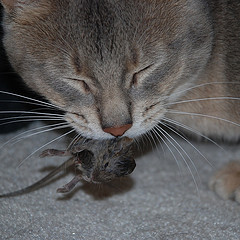
Sometimes it’s easy to forget that our pet cats are predators at heart, especially if you just fill their bowl of kibble every now and then. But beneath that fuzzy, cute exterior is a potentially vicious killer, even if your cat doesn’t have the opportunity to practice mass destruction of small animals. That’s where playtime with interactive toys comes in! But more on that later!
There are two major categories of predators: specialists – those who hunt just one or two prey types; and generalists – animals with a broad diet or who may show a wide range of prey preferences within a species. Both types are likely related to prey available, and how an animal has adapted over time to that prey availability. These preferences could be learned during development, such as when a mother cat brings injured prey to her kittens, or could be a response to changes in the environment. If prey abundance changes, predators have to change their responses too…or go hungry.
A recent study (Individual hunting behaviour and prey specialisation in the house cat Felis catus: Implications for conservation and management) looked at the hunting behavior of domestic cats. The main question was if small cats are similar to some of their bigger relatives, such as cougars, who have individual preferences for types of prey. For example, some cougars are deer specialists, while others prefer sheep.
The first part of the study surveyed 105 cat owners in Austr-lia who were willing to keep a log of what prey their kitties brought home. Of those, 62 cats (34 female, age range from one to 12 years old) brought home prey items (between one and 58 prey items per cat) during the year or so of the study, for a whopping total of 667 dead animals! The prey were mostly birds, with lizards and rats not far behind, and a few bugs and snakes rounding out the bunch. The survey revealed that most kitties were specialists – either preferring small birds, lizards, rodents, or large birds. A handful of cats were generalists, equal opportunity killers. Being fed by owners did not seem to influence the amount of killing.
Next, the researchers observed cats killing their prey, by sneakily observing them from a distance, to see how efficient they actually were at catching animals (efficiency was measured by percentage of attempts that led to a kill). One hundred and eighty two hunting attempts were observed by 15 different outdoor cats (with 50-100% success, depending on the individual). Four were most efficient with rodents; one was really great at hunting rabbits, and the rest seemed to be equally efficient with different types of prey.
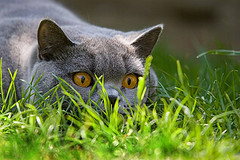
The cats showed different strategies for killing, some preferring to ambush from an open clearing, others preferring to stalk-and-rush from behind tall, grassy cover. Others waited for their prey to pop out of entrances to burrows and warrens.
Finally, researchers looked at just what was in cat poo, examining 329 samples, pulling teeth, beaks, feathers, antennae and other things out of cat scat. SCIENCE! The poop had more rabbit bits than anything else, but the researchers found that this abundance of rabbit bits in poo was not dependent on the density of rabbits in the area. Meaning that preferences for prey types are not necessarily dependent on whether or not there is plenty of that type of prey around to catch. Cats have preferences that they stick to!
So, from this study, we learned that cats have individual differences in prey types they prefer, and that some kitties are better at hunting some types of animals than others. The authors are hoping to apply this information to a more conservationist end (including cat “management” – i.e. trapping and killing cats). I’d like to apply it to how we play with our own cats.
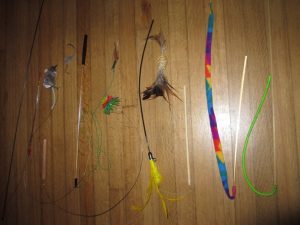
Do you have different toys to represent different prey types? A one-toy-fits-all approach might not work, especially if you have multiple cats, or your kitty is a generalist, rather than a specialist. We already know from previous research that cats get bored of the same toy before they get bored of playing, so that is another good reason to have a selection of interactive toys (including multiple options for each prey type). So be sure to have some toys that represent bird-like prey (feather wands), snakey things (such as the Cat Charmer), buggishness (Neko Flies or Cat Dancer), and of course, plenty of rodent options (the Cat Catcher is excellent).

As I like to say, be sure to move your toys like prey – and allow your cat to use different hunting strategies! Sometimes your cat may like to have cover, like the tall grass the kitties hid behind in the study. A box or under a chair might do! Other cats may want to wait by an entrance, so try cutting a hole in a box for your feather wand to pop out of! Move the toy slowly behind the hole, allowing your cat an occasional glimpse at the prey item within.
From this study, we also know that well-fed doesn’t necessarily mean lazy. Your kibble-eating kitties will still want to hunt. So be sure to give your Natural Born Killer an opportunity to practice those instincts!
What type of interactive toys does your kitty like?
Is your cat a generalist or a specialist?

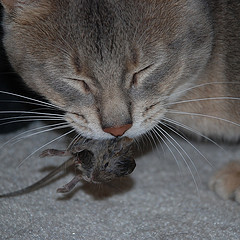
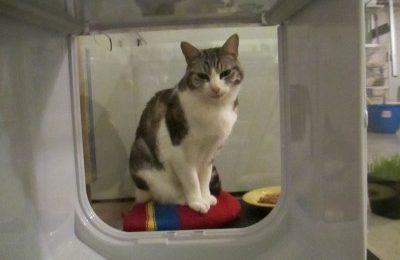
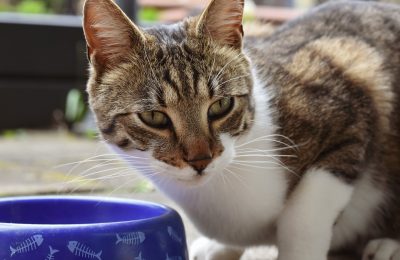
2 thoughts on “Natural Born Killers: Cats show individual differences for favorite prey types”